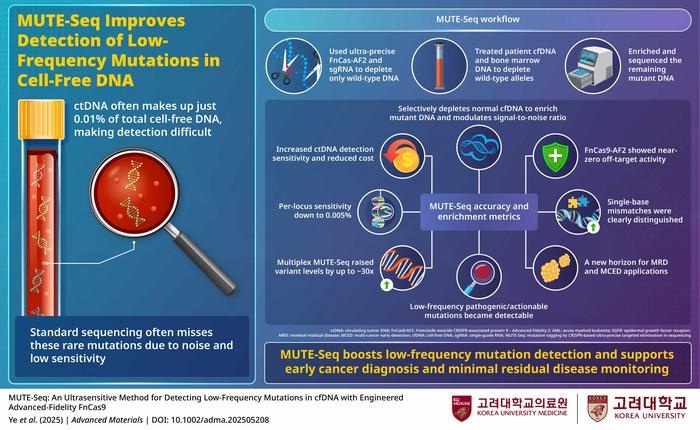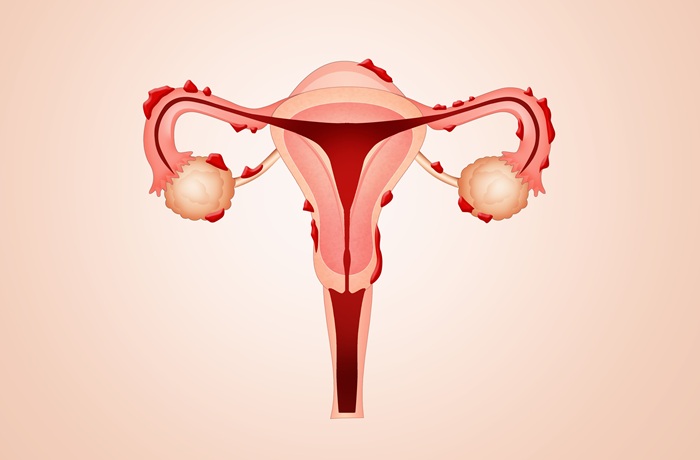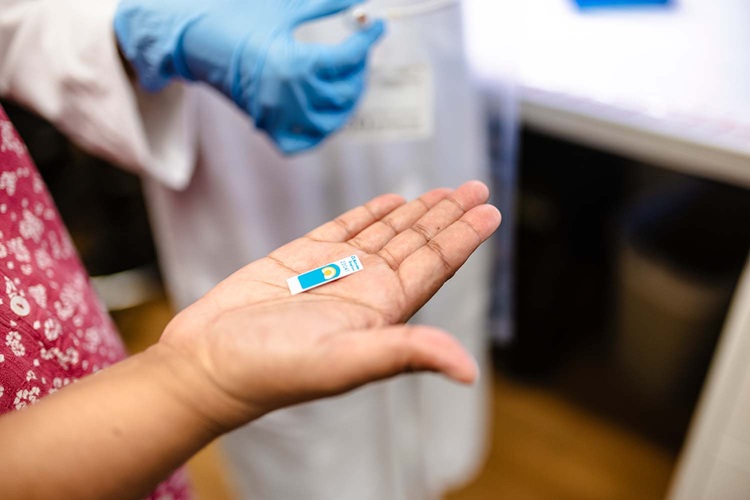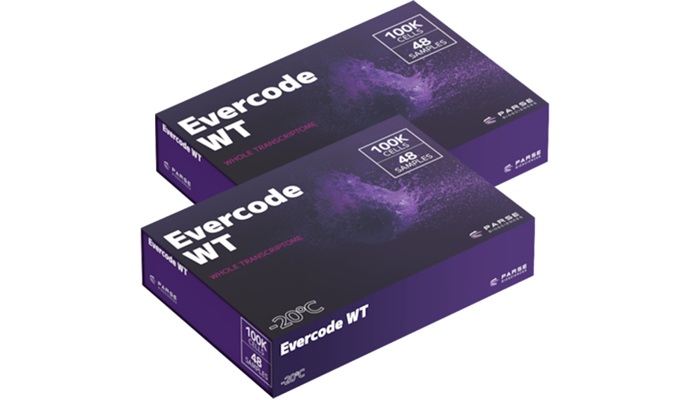Noninvasive Glucose Sensing Uses Mid-Infrared Light
|
By LabMedica International staff writers Posted on 01 Sep 2014 |
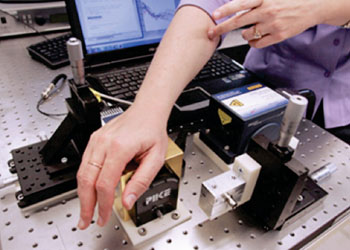
Image: The new monitor uses a laser to read blood sugar levels. The laser is directed at the person\'s palm, passes through skin cells and is partially absorbed by sugar molecules, allowing scientists to calculate the level of blood sugar (Photo courtesy of Princeton University, Engineering School).
A laser has been developed to measure people's blood sugar, and the technique could allow diabetics to check their condition without pricking themselves to draw blood.
Bioengineers at the Princeton University (NJ, USA) utilized a hollow-core fiber based optical setup for light delivery and collection along with a broadly tunable quantum cascade laser to obtain spectra from human subjects and use standard chemometric techniques. In vivo glucose sensing using mid-infrared (IR) spectra was conducted with three healthy human subjects starting on an empty stomach with glucose levels were typically around 80 mg/dL at this time to obtain spectra for their low levels.
Light from a pulsed external cavity Quantum Cascade Laser (Daylight Solutions Inc.; San Diego, CA, USA) with a tuning range between 8–10 μm was focused into a 500 μm diameter hollow-core fiber (Opto-Knowledge Systems, Inc.; Torrance, CA, USA) responsible for delivering light onto a region of the human palm between the thumb and index finger. Backscattered light from the skin was collected using a bundle of six fibers, identical in composition and size to the delivery fiber, arranged in a circular fashion around the delivery fiber and coupled directly to a commercial liquid nitrogen cooled mercury cadmium telluride (MCT) detector.
Numerical values for a subject’s blood glucose concentration level were obtained using a commercial electrochemical meter (OneTouch; High Wycombe, UK) prior to the optical study. Up to ten spectra were taken for each concentration, with a single spectral scan taking roughly 20 seconds; upon conclusion of such a set, the subject once again obtained a reading from the commercial meter to ascertain the stability of blood glucose levels throughout the elapsed time period.
The mid-IR spectra obtained in vivo from human skin yield clinically accurate predictions for blood glucose levels for concentrations between 75–160 mg/dL using both partial least-squares regression (PLSR) and derivative spectroscopy techniques with given calibration sets yielded average errors only 2% more than those from a commercial electrochemical meter. The glucose absorption features in mid-IR skin visibly change with respect to increasing concentration, as absorption minima increase in depth and width. The authors concluded that this application of mid-IR light to noninvasive in vivo glucose sensing yields a robust and clinically accurate system that transcends boundaries set in the past which limited the scope of mid-IR in vivo applications.
Claire Gmachl, PhD, a professor of Electrical Engineering and senior author of the study, said, “With this work we hope to improve the lives of many diabetes sufferers who depend on frequent blood glucose monitoring. Because the quantum cascade laser can be designed to emit light across a very wide wavelength range, its usability is not just for glucose detection, but could conceivably be used for other medical sensing and monitoring applications.” The scientists are working on ways make the device much smaller. The study was published on July 1, 2014, in the journal Biomedical Optics Express.
Related Links:
Princeton University
Daylight Solutions
Opto-Knowledge Systems
Bioengineers at the Princeton University (NJ, USA) utilized a hollow-core fiber based optical setup for light delivery and collection along with a broadly tunable quantum cascade laser to obtain spectra from human subjects and use standard chemometric techniques. In vivo glucose sensing using mid-infrared (IR) spectra was conducted with three healthy human subjects starting on an empty stomach with glucose levels were typically around 80 mg/dL at this time to obtain spectra for their low levels.
Light from a pulsed external cavity Quantum Cascade Laser (Daylight Solutions Inc.; San Diego, CA, USA) with a tuning range between 8–10 μm was focused into a 500 μm diameter hollow-core fiber (Opto-Knowledge Systems, Inc.; Torrance, CA, USA) responsible for delivering light onto a region of the human palm between the thumb and index finger. Backscattered light from the skin was collected using a bundle of six fibers, identical in composition and size to the delivery fiber, arranged in a circular fashion around the delivery fiber and coupled directly to a commercial liquid nitrogen cooled mercury cadmium telluride (MCT) detector.
Numerical values for a subject’s blood glucose concentration level were obtained using a commercial electrochemical meter (OneTouch; High Wycombe, UK) prior to the optical study. Up to ten spectra were taken for each concentration, with a single spectral scan taking roughly 20 seconds; upon conclusion of such a set, the subject once again obtained a reading from the commercial meter to ascertain the stability of blood glucose levels throughout the elapsed time period.
The mid-IR spectra obtained in vivo from human skin yield clinically accurate predictions for blood glucose levels for concentrations between 75–160 mg/dL using both partial least-squares regression (PLSR) and derivative spectroscopy techniques with given calibration sets yielded average errors only 2% more than those from a commercial electrochemical meter. The glucose absorption features in mid-IR skin visibly change with respect to increasing concentration, as absorption minima increase in depth and width. The authors concluded that this application of mid-IR light to noninvasive in vivo glucose sensing yields a robust and clinically accurate system that transcends boundaries set in the past which limited the scope of mid-IR in vivo applications.
Claire Gmachl, PhD, a professor of Electrical Engineering and senior author of the study, said, “With this work we hope to improve the lives of many diabetes sufferers who depend on frequent blood glucose monitoring. Because the quantum cascade laser can be designed to emit light across a very wide wavelength range, its usability is not just for glucose detection, but could conceivably be used for other medical sensing and monitoring applications.” The scientists are working on ways make the device much smaller. The study was published on July 1, 2014, in the journal Biomedical Optics Express.
Related Links:
Princeton University
Daylight Solutions
Opto-Knowledge Systems
Latest Clinical Chem. News
- Online Tool Detects Drug Exposure Directly from Patient Samples
- Chemical Imaging Probe Could Track and Treat Prostate Cancer
- Mismatch Between Two Common Kidney Function Tests Indicates Serious Health Problems
- VOCs Show Promise for Early Multi-Cancer Detection
- Portable Raman Spectroscopy Offers Cost-Effective Kidney Disease Diagnosis at POC
- Gold Nanoparticles to Improve Accuracy of Ovarian Cancer Diagnosis
- Simultaneous Cell Isolation Technology Improves Cancer Diagnostic Accuracy
- Simple Non-Invasive Hair-Based Test Could Speed ALS Diagnosis
- Paper Strip Saliva Test Detects Elevated Uric Acid Levels Without Blood Draws
- Prostate Cancer Markers Based on Chemical Make-Up of Calcifications to Speed Up Detection
- Breath Test Could Help Detect Blood Cancers
- ML-Powered Gas Sensors to Detect Pathogens and AMR at POC
- Saliva-Based Cancer Detection Technology Eliminates Need for Complex Sample Preparation
- Skin Swabs Could Detect Parkinson’s Years Before Symptoms Appear
- New Clinical Chemistry Analyzer Designed to Meet Growing Demands of Modern Labs

- New Reference Measurement Procedure Standardizes Nucleic Acid Amplification Test Results
Channels
Molecular Diagnostics
view channel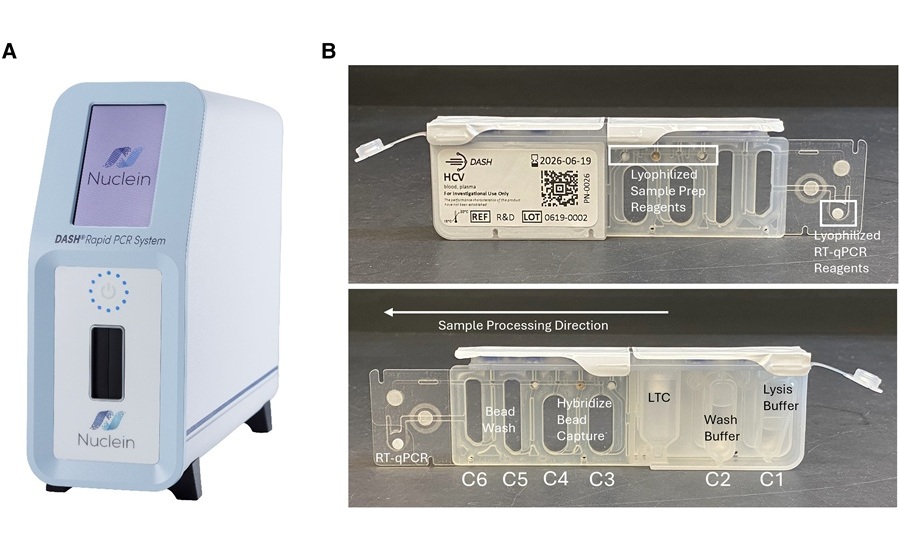
New 15-Minute Hepatitis C Test Paves Way for Same-Day Treatment
Chronic hepatitis C infection affects an estimated 50 million people worldwide and causes around 242,000 deaths each year, largely due to cirrhosis and liver cancer. Although the infection is curable with... Read more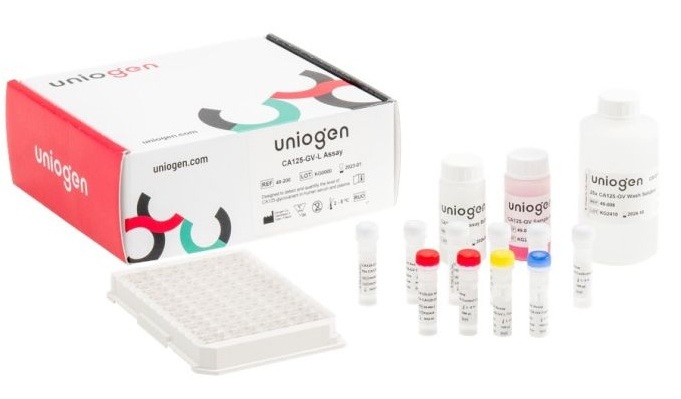
Ovarian Cancer Assay Outperforms Traditional Tests in Early Disease Detection
Globally, ovarian cancer is one of the deadliest cancers affecting women. Traditionally, early diagnosis of ovarian cancer has been challenging. Many ovarian cancers are diagnosed only after they have... Read moreHematology
view channel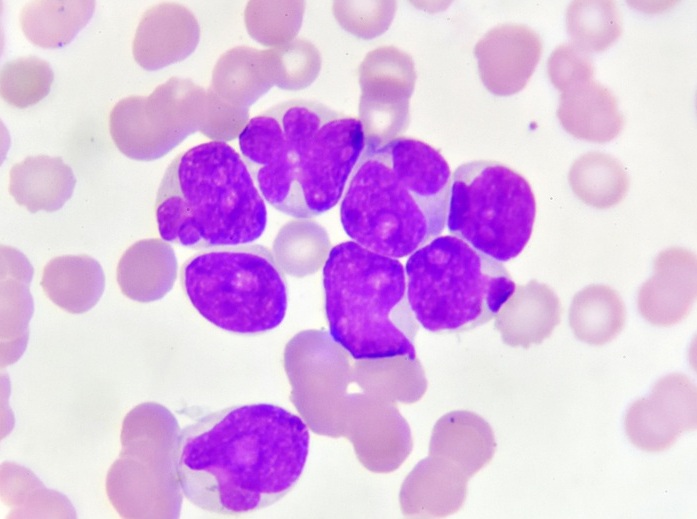
MRD Tests Could Predict Survival in Leukemia Patients
Acute myeloid leukemia is an aggressive blood cancer that disrupts normal blood cell production and often relapses even after intensive treatment. Clinicians currently lack early, reliable markers to predict... Read more
Platelet Activity Blood Test in Middle Age Could Identify Early Alzheimer’s Risk
Early detection of Alzheimer’s disease remains one of the biggest unmet needs in neurology, particularly because the biological changes underlying the disorder begin decades before memory symptoms appear.... Read more
Microvesicles Measurement Could Detect Vascular Injury in Sickle Cell Disease Patients
Assessing disease severity in sickle cell disease (SCD) remains challenging, especially when trying to predict hemolysis, vascular injury, and risk of complications such as vaso-occlusive crises.... Read more
ADLM’s New Coagulation Testing Guidance to Improve Care for Patients on Blood Thinners
Direct oral anticoagulants (DOACs) are one of the most common types of blood thinners. Patients take them to prevent a host of complications that could arise from blood clotting, including stroke, deep... Read moreImmunology
view channel
Routine Blood Test Can Predict Who Benefits Most from CAR T-Cell Therapy
CAR T-cell therapy has transformed treatment for patients with relapsed or treatment-resistant non-Hodgkin lymphoma, but many patients eventually relapse despite an initial response. Clinicians currently... Read more
New Test Distinguishes Vaccine-Induced False Positives from Active HIV Infection
Since HIV was identified in 1983, more than 91 million people have contracted the virus, and over 44 million have died from related causes. Today, nearly 40 million individuals worldwide live with HIV-1,... Read more
Gene Signature Test Predicts Response to Key Breast Cancer Treatment
DK4/6 inhibitors paired with hormone therapy have become a cornerstone treatment for advanced HR+/HER2– breast cancer, slowing tumor growth by blocking key proteins that drive cell division.... Read more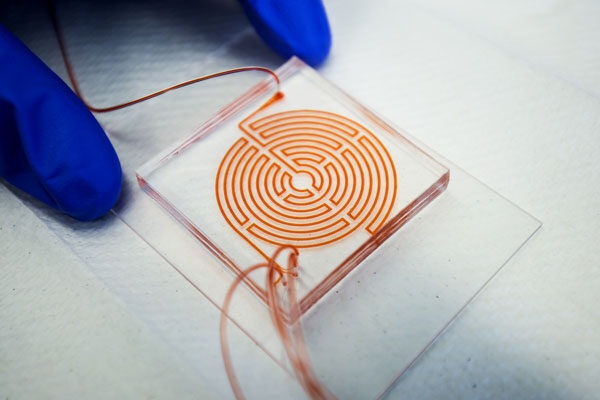
Chip Captures Cancer Cells from Blood to Help Select Right Breast Cancer Treatment
Ductal carcinoma in situ (DCIS) accounts for about a quarter of all breast cancer cases and generally carries a good prognosis. This non-invasive form of the disease may or may not become life-threatening.... Read moreMicrobiology
view channel
Blood-Based Diagnostic Method Could Identify Pediatric LRTIs
Lower-respiratory tract infections (LRTIs) are a leading cause of illness and death worldwide, and pneumonia is the leading infectious cause of death in children under five, claiming the lives of over... Read more
Rapid Diagnostic Test Matches Gold Standard for Sepsis Detection
Sepsis kills 11 million people worldwide every year and generates massive healthcare costs. In the USA and Europe alone, sepsis accounts for USD 100 billion in annual hospitalization expenses.... Read moreRapid POC Tuberculosis Test Provides Results Within 15 Minutes
Tuberculosis remains one of the world’s deadliest infectious diseases, and reducing new cases depends on identifying individuals with latent infection before it progresses. Current diagnostic tools often... Read more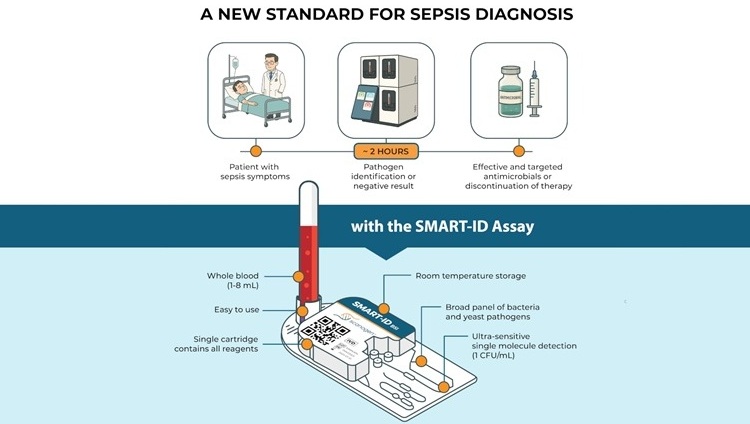
Rapid Assay Identifies Bloodstream Infection Pathogens Directly from Patient Samples
Bloodstream infections in sepsis progress quickly and demand rapid, precise diagnosis. Current blood-culture methods often take one to five days to identify the pathogen, leaving clinicians to treat blindly... Read morePathology
view channel
Rapid Low-Cost Tests Can Prevent Child Deaths from Contaminated Medicinal Syrups
Medicinal syrups contaminated with toxic chemicals have caused the deaths of hundreds of children worldwide, exposing a critical gap in how these products are tested before reaching patients.... Read more
Tumor Signals in Saliva and Blood Enable Non-Invasive Monitoring of Head and Neck Cancer
Head and neck cancers are among the most aggressive malignancies worldwide, with nearly 900,000 new cases diagnosed each year. Monitoring these cancers for recurrence or relapse typically relies on tissue... Read more
Common Health Issues Can Influence New Blood Tests for Alzheimer’s Disease
Blood-based tests for Alzheimer’s disease are transforming diagnosis by offering a simpler alternative to spinal taps and brain imaging. However, many people evaluated at memory clinics also live with... Read more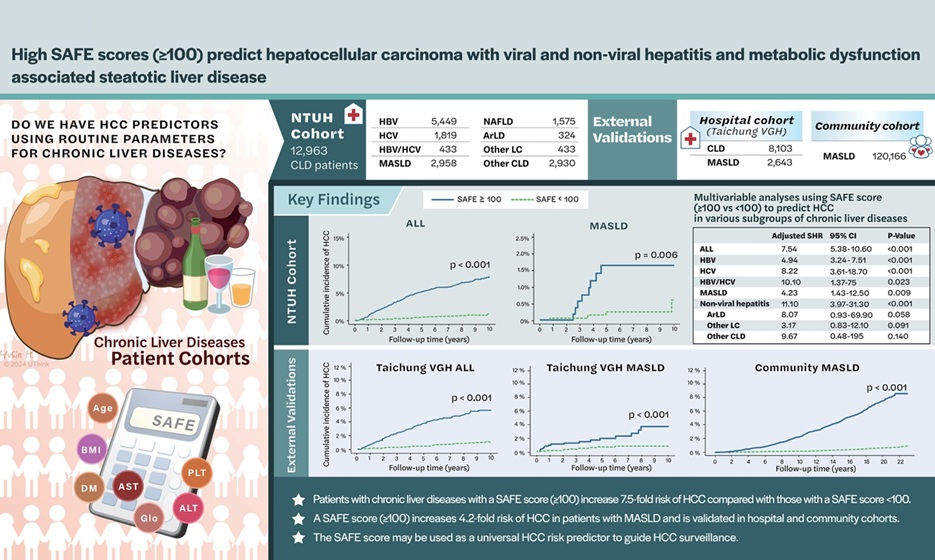
Blood Test Formula Identifies Chronic Liver Disease Patients with Higher Cancer Risk
Chronic liver disease affects millions worldwide and can progress silently to hepatocellular carcinoma (HCC), one of the deadliest cancers globally. While surveillance guidelines exist for patients with... Read moreTechnology
view channel
Machine Learning Models Diagnose ALS Earlier Through Blood Biomarkers
Amyotrophic lateral sclerosis (ALS) is a rapidly progressive neurodegenerative disease that is notoriously difficult to diagnose in its early stages. Early symptoms often overlap with other neurological... Read more
Artificial Intelligence Model Could Accelerate Rare Disease Diagnosis
Identifying which genetic variants actually cause disease remains one of the biggest challenges in genomic medicine. Each person carries tens of thousands of DNA changes, yet only a few meaningfully alter... Read moreIndustry
view channel
Abbott Acquires Cancer-Screening Company Exact Sciences
Abbott (Abbott Park, IL, USA) has entered into a definitive agreement to acquire Exact Sciences (Madison, WI, USA), enabling it to enter and lead in fast-growing cancer diagnostics segments.... Read more











